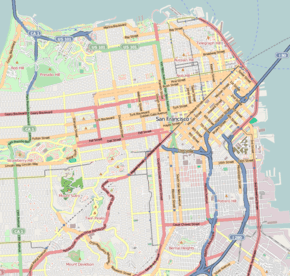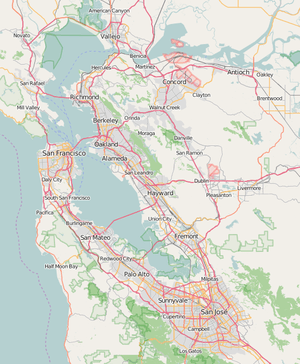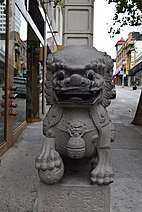Dragon Gate (San Francisco)
The Dragon Gate ("Chinatown Gate" on some maps) is a south-facing gate at the intersection of Bush Street and Grant Avenue, marking a southern entrance to San Francisco's Chinatown, in the U.S. state of California. Built in 1969 as a gift from the Republic of China (Taiwan) in the style of a traditional Chinese pailou ,[1] it became one of the most photographed locations in Chinatown, along with the older Sing Fat and Sing Chong buildings (at Grant and California).
The gate in 2010 | |
 Location in San Francisco  Dragon Gate (San Francisco) (San Francisco Bay Area) | |
| Coordinates | 37.7907°N 122.4056°W |
|---|---|
| Location | Straddling Grant just north of Bush, San Francisco |
| Designer | Clayton Lee, Melvin Lee, and Joseph Yee |
| Opening date | October 18, 1970 |
History
In 1953, the Chinese Chamber of Commerce sponsored a bilingual essay contest on how to improve Chinatown business, in the wake of an U.S. embargo on mainland China imports after the People's Republic of China entered the Korean conflict. The winner of the English division, Charles L. Leong, suggested in his essay, among many things, the erection of an authentic archway to Chinatown at Bush and Grant.[2] A later report from 1963 proposing general plans for the downtown area noted that "north of Bush Street, Grant Avenue, to the casual observer and the visitor, is Chinatown", establishing the site's suitability.[3]
In 1956, the Chinatown Improvement Committee, appointed by Mayor George Christopher, made the archway its top priority, but further progress was stalled;[2]:148–151 an early effort to build a gate which started in 1958[4] was suspended in 1961 after funds and materials ran short,[5] then abandoned in 1962.[6] The gate was redesigned in 1963 by Lun Chan, Worley Wong, Morton Rader, and Piero Patri as part of a more ambitious plan to link Chinatown and North Beach via a pedestrian mall and bridge.[4]
In 1967 Mayor John F. Shelley, Mayor Christopher's successor, also championed the project and sponsored a design competition. This contest to design a gateway was won[7] by a team of three Chinese-Americans, landscape architects Melvin H. Lee (design concept), Joseph Yee, along with architect Clayton Lee, who were inspired by Chinese village architecture of ceremonial gates.[8][9] There were twenty entrants in the contest, judged by a jury of five.[7] Materials for the gateway, viz., 120 artisanal ochre tiles, were donated by the Republic of China (Taiwan) in 1969.[2]:252 [10][11]
Although the gateway was largely completed by April 1969,[12] it was not dedicated until October 18, 1970; Mayor Joseph Alioto, Mayor Shelly's successor, and Vice-President Yen Chia-kan of the Republic of China (Taiwan) attended the ceremony.[2]:151–152 [8]
The Dragon Gate, with its inscription by Sun Yat-sen, has been described as embodying "the ROC government['s] symbolic claim on Chinatown", before the People's Republic of China gained more influence in Chinatown following Nixon's 1972 visit to China and further normalization of US-China relations.[1]
Design
Like most Chinese ceremonial gates, the Chinatown Gateway has three portals facing south. The two smaller west and east (pedestrian) portals flank the larger central (automotive) portal, and the structure is supported on stone columns rising from the sidewalks on either side of Grant. The stone columns adhere to standards for Chinese gateways;[8][9] in contrast, most 'Chinese' gateways constructed in the United States use wooden support columns.[13] Each portal is covered with green tiles, leading north along Grant Avenue into Chinatown.
Three shallow steps lead up to each pedestrian portal. Each pedestrian portal features a stone Chinese guardian lion on the side away from the street. By tradition, the lion pair consists of one male and one female. The male lion, at the west portal, stands with his right fore paw atop a pearl or stone, symbolically guarding the structure or empire. The female lion, at the east portal, stands with her left fore paw atop a juvenile lion, symbolically guarding the occupants within.[8] There are also fish and dragons atop the gate; the fish symbolize prosperity, while the dragons symbolize power and fertility. Between the dragons is a ball, symbolizing the earth.[14]
(信義和平)
(天下為公)
(忠孝仁愛)
There are four Chinese characters above each portal. Each sign is read from right to left. The central portal sign reads Chinese: 天下為公; pinyin: tiānxià wèi gōng; lit.: 'All under heaven is for the good of the people' (a motto attributed to Dr. Sun Yat-sen);[8] the east portal sign reads 忠孝仁愛; zhōngxiào rén'ài; 'respect (filial piety); love'; and the west reads 信義和平; xìnyì hépíng; 'trust (confidence); peace'.[15]
See also
References
- Lei, D. (2016). Operatic China: Staging Chinese Identity Across the Pacific. Springer. ISBN 978-1-137-06163-8.
- Wu, Ellen D (2015). "Deghettoizing Chinatown: race and space in postwar America". In Bay, Mia; Fabian, Ann (eds.). Race and retail: consumption across the color line. Rutgers University Press. pp. 141–162. ISBN 978-0-8135-7172-0.
- Ciampi, Mario (September 1963). Downtown San Francisco: General plan proposals (Report). San Francisco Department of City Planning. Retrieved 20 April 2020.
- "A New Gateway to Chinatown". San Francisco Examiner. May 22, 1963. p. 4.
- "Chinatown Waits: Gateway Arch Delayed Again". San Francisco Examiner, Sunday. May 21, 1961. p. 35.
- "Chinatown Gate 'Closed'". San Francisco Examiner. April 20, 1962. p. 5.
- "Chinatown Gateway Selected: Designed by Architect Lee". San Francisco Examiner, Sunday. March 26, 1967. p. 26.
- Casey, Cindy (11 May 2012). "Chinatown – Gateway Arch". Public Art and Architecture from Around the World. Retrieved 10 March 2018.
- Bevk, Alex (24 July 2017). "Chinatown's Grant Avenue: A look back at one of San Francisco's oldest streets". Curbed San Francisco. Retrieved 11 March 2018.
- Brinklow, Adam (28 July 2017). "Mapping 16 Chinatown landmarks and their history: #16 Dragon Gate". Curbed San Francisco. Retrieved 11 March 2018.
- "Chinatown, San Francisco, California". hiddenSF. Retrieved 11 March 2018.
- "A Literal Gateway to Chinatown". San Francisco Examiner. April 2, 1969. p. 20.
- "Shopping, dining and culture in San Francisco's Chinatown". San Francisco Travel. Retrieved 11 March 2018.
- Fong-Torres, Shirley (1991). San Francisco Chinatown: a walking tour. China Books & Periodicals, Inc. p. 47. ISBN 9780835124362. Retrieved 20 April 2020.
- "San Francisco sights: Chinatown Gate". Fodor's. Retrieved 10 March 2018.
External links
| Wikimedia Commons has media related to Dragon Gate, San Francisco. |
- Davis, Chelsea (January 2016). "Episode 192: Pagodas and Dragon Gates". 99% Invisible. Retrieved 11 March 2018.

.jpg)
